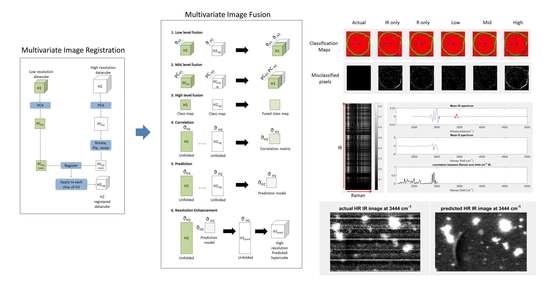Multivariate Chemical Image Fusion of Vibrational Spectroscopic Imaging Modalities
Abstract
:1. Introduction
2. Multivariate CI Registration
- Starting with two chemical image cubes, one obtained using a lower resolution modality (H1) and the other obtained using a higher resolution modality (H2), principal component analysis (PCA) was applied to each chemical image cube individually. The resultant PC score images were visually examined and compared between modes. One PC score image, corresponding to common salient features of the sample, was selected for each modality (PCH1 & PCH2).
- The PC score images selected in step 1 were thresholded, based on their histograms, to create a binary mask exposing the common salient features.
- The higher resolution PC mask image was rotated and flipped to match the orientation of the lower resolution one. This was followed by down-sampling of the higher resolution image to the approximate size of the lower resolution image, resulting in a PC score mask image for the 2nd modality (PCH2r) with similar orientation and size to that of the 1st modality (PCH1). Images were down-sampled using the “imresize” function of the Matlab image processing toolbox [10]. This function works by resizing a two dimensional image to a target size using bicubic interpolation.
- An affine transformation to register the down-sampled image to the lower resolution image was optimised using a regular step gradient descent method. Image registration parameters were obtained from the binary masks created in step 3 and optimized using the “imregtform” function of the Matlab image processing toolbox [10]. This function takes two input images of the same size: one is regarded as fixed, this is the reference image, and the other is regarded as moving, this is the image that will be transformed to match the spatial arrangement of the fixed image. The transformation is defined by optimising a criterion, in this case study the mean square difference between the fixed and transformed image was minimised. The output of this function is an affine transformation which can then be applied to individual slices of the chemical image that requires registration.
- Each slice of the higher resolution chemical image cube (H2) was then rotated, flipped, resized (according to the procedure defined in step 3) and the affine transformation optimised in step 4 was applied, resulting in a new registered chemical image cube where each pixel matches that of the lower resolution one.
3. Multivariate CI Fusion
- Low-level fusion: spatially registered image cubes were concatenated to make a fused chemical image cube. Multivariate analysis (i.e., pixel classification using partial least squares discriminant analysis (PLS-DA—further details are given in the data analysis section) was applied to this chemical image cube.
- Mid-level fusion: outputs from data reduction (i.e., PCA) were fused, followed by pixel classification.
- High-level fusion: outputs from classification applied to each cube separately were fused.
- Co-inertia analysis: unfolded, registered cubes were subjected to co-inertia analysis, as described in [7]. This method generates global co-inertia scores and loadings from concatenated unfolded registered chemical images, sequentially deflated by the contribution of each chemical image (or “block”) to the global co-inertia scores and loadings. This enables analysis of the contribution of each data block to the overall covariance in the global dataset described by each co-inertia component and examination of the correlation between each block and global component. Further details on the metrics extracted from the co-inertia analysis are given in the data analysis section.
- Correlation analysis: the Pearson correlation coefficient [11] between spectra from the spatially registered data was calculated to reveal spectral correlations between modalities.
- Prediction: multivariate regression models were built to predict spectra from one modality from the other. The registered data was divided into training, calibration and test data and PLSR models were developed to predict intensity at a given spectral variable. Further details on the PLSR models are given in the data analysis section.
- Resolution enhancement: Using the predictive models developed in method 6, IR chemical image cubes were predicted from high resolution Raman chemical image cubes. The predicted images were evaluated by comparison with the actual high resolution IR image.
4. Results & Discussion
4.1. Multivariate Image Registration
4.1.1. Selection of Target Images for Image Registration
4.1.2. Conversion of Target Images into Mask Images
4.1.3. Rotation of Mask Images
4.1.4. Registration of Target Images
4.1.5. Multivariate Chemical Image Registration
4.2. Multivariate Data Fusion
4.2.1. Multivariate Data Fusion for Pixel Classification
4.2.2. Low-Level Fusion
4.2.3. Mid-Level Fusion
4.2.4. High-Level Fusion
4.2.5. Co-Inertia Analysis
4.2.6. Correlation Analysis
4.3. Cross Modality Prediction
4.3.1. Prediction at Low Resolution
4.3.2. Resolution Enhancement
5. Experimental Section
5.1. Materials and Methods
5.1.1. IR Instrumentation
5.1.2. Raman Instrumentation
5.1.3. NIR Instrumentation
5.1.4. Vis-NIR Instrumentation
5.2. Image Sets
5.2.1. Image Set 1
5.2.2. Image Set 2
5.2.3. Image Set 3
5.3. Data Analysis
5.3.1. Data Pre-Processing
5.3.2. Co-Inertia Analysis
5.4. PLS-DA Model Building
5.5. PLSR Model Building
6. Conclusions
Supplementary Materials
Acknowledgments
Author Contributions
Conflicts of Interest
References
- Gowen, A.A.; Marini, F.; Esquerre, C.; O’Donnell, C.; Downey, G.; Burger, J. Time series hyperspectral chemical imaging data: Challenges, solutions and applications. Anal. Chim. Acta 2011, 705, 272–282. [Google Scholar] [CrossRef] [PubMed]
- Pu, Y.Y.; Sun, D.W. Vis-NIR hyperspectral imaging in visualizing moisture distribution of mango slices during microwave-vacuum drying. Food Chem. 2015, 188, 271–278. [Google Scholar] [CrossRef] [PubMed]
- Licciardi, G.A.; Khan, M.M.; Chanussot, J.; Montanvert, A.; Condat, L.; Jutten, C. Fusion of hyperspectral and panchromatic images using multiresolution analysis and nonlinear PCA band reduction. J. Adv. Signal Process. 2012, 207, 1–17. [Google Scholar] [CrossRef]
- Ewing, A.V.; Wray, P.S.; Clarke, G.S.; Kazarian, S.G. Evaluating drug delivery with salt formation: Drug disproportionation studied in situ by ATR-FTIR imaging and Raman mapping. J. Pharm. Biomed. Anal. 2015, 111, 248–256. [Google Scholar] [CrossRef] [PubMed]
- Clarke, F.C.; Jamieson, M.J.; Clark, D.A.; Hammond, S.V.; Jee, R.D.; Moffatt, A.C. Chemical image fusion. The synergy of FT-NIR and raman mapping microscopy to enable a more complete visualization of pharmaceutical formulations. Anal. Chem. 2001, 73, 2213–2220. [Google Scholar] [CrossRef] [PubMed]
- Artyushkova, K.; Farrar, J.O.; Fulghum, J.E. Data fusion of XPS and AFM images for chemical phase identification in polymer blends. Surf. Interface Anal. 2009, 41, 119–126. [Google Scholar] [CrossRef]
- Allouche, F.; Hanafi, M.; Jamme, F.; Robert, P.; Barron, C.; Guillon, F.; Devaux, M.F. Coupling hyperspectral image data having different spatial resolutions using Multiple Co-inertia Analysis. Chemom. Intell. Lab. Syst. 2012, 117, 200–212. [Google Scholar] [CrossRef]
- Allouche, F.; Hanafi, M.; Jamme, F.; Robert, P.; Guillon, F.; Devaux, M.F. Coupling hyperspectral image data having different spatial resolutions by extending multivariate inter-battery Tucker analysis. Chemom. Intell. Lab. Syst. 2012, 113, 43–51. [Google Scholar] [CrossRef]
- Van de Plas, R.; Yang, J.; Spraggins, J.; Caprioli, R.M. Image fusion of mass spectrometry and microscopy: A multimodality paradigm for molecular tissue mapping. Nat. Methods 2015, 12, 366–372. [Google Scholar] [CrossRef] [PubMed]
- MATLAB. R2014b and Image Processing Toolbox Version R2014b; The Mathworks Inc.: Natick, MA, USA, 2014. [Google Scholar]
- Varmuza, K.; Filzmoser, P. Introduction to Multivariate Statistical Analysis in Chemometrics; CRC Press: Boca Raton, FL, USA, 2016. [Google Scholar]
- Taghizadeh, M.; Gowen, A.A.; O’Donnell, C.P. The potential of visible-near infrared hyperspectral imaging to discriminate between casing soil, enzymatic browning and undamaged tissue on mushroom (Agaricus bisporus) surfaces. Comput. Electron. Agric. 2011, 77, 74–80. [Google Scholar] [CrossRef]
- Mukherjee, S.; Gowen, A. Chemical imaging of solvent cast poly-l-lactic Acid (PLLA) and ply-3-hydroxybutyrate (P3HB) thin film blend using mid infrared imaging-chemical image (MIR-CI). Biosyst. Eng. Res. Rev. 2015, 1–4. [Google Scholar] [CrossRef]
- Example Data (Image set 2) and Associated Matlab Scripts. Available online: http://www.ucd.ie/biowater/datasets/ (accessed on 13 April 2016).
- Dorrepaal, R.; Malegori, C.; Gowen, A. Tutorial: Time series hyperspectral image analysis. J. Near Infrared Spectrosc. 2016, 24, 89–108. [Google Scholar] [CrossRef]
- Gowen, A.A.; Downey, G.; Esquerre, C.; O’Donnell, C.P. Preventing over-fitting in PLS calibration models of near-infrared (NIR) spectroscopy data using regression coefficients. J. Chemom. 2011, 25, 375–381. [Google Scholar] [CrossRef]
- Sample Availability: Samples of the compounds are available from the authors on request.
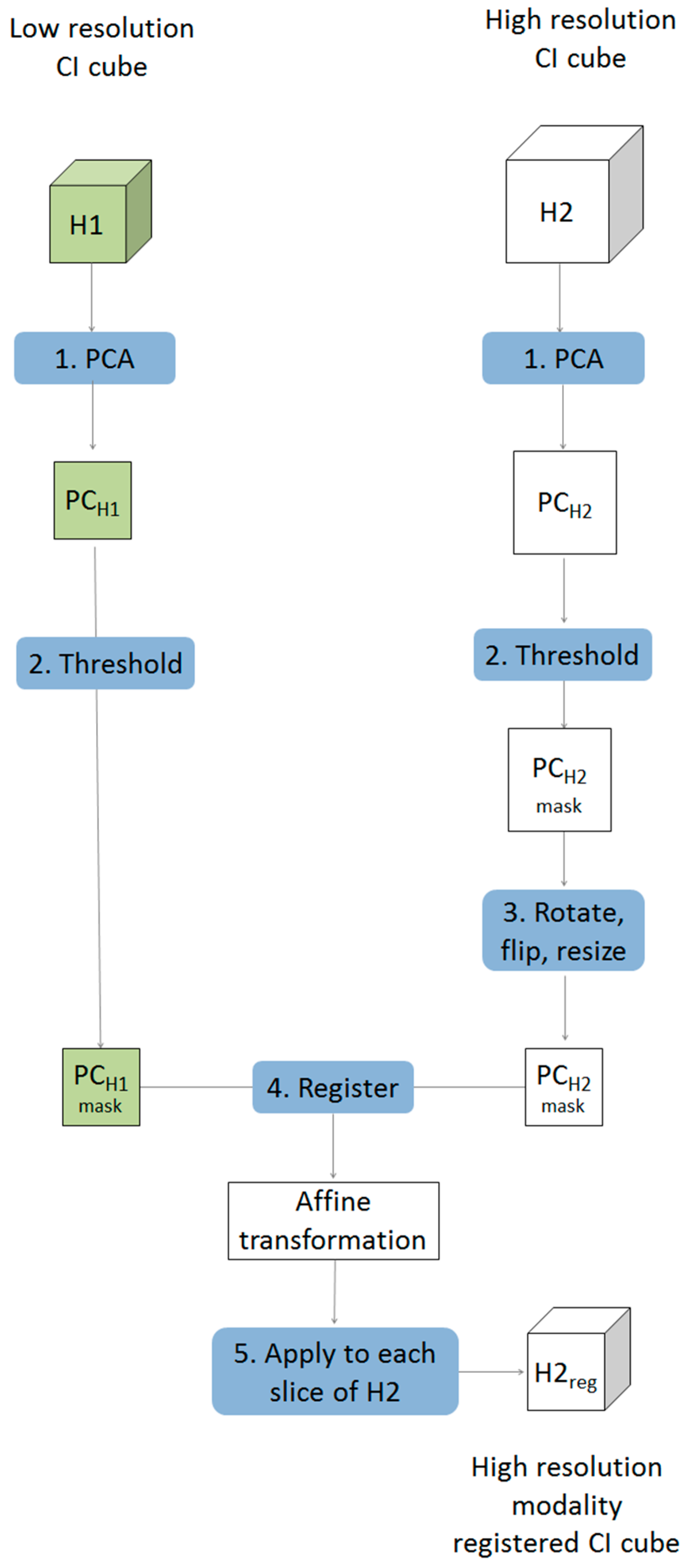

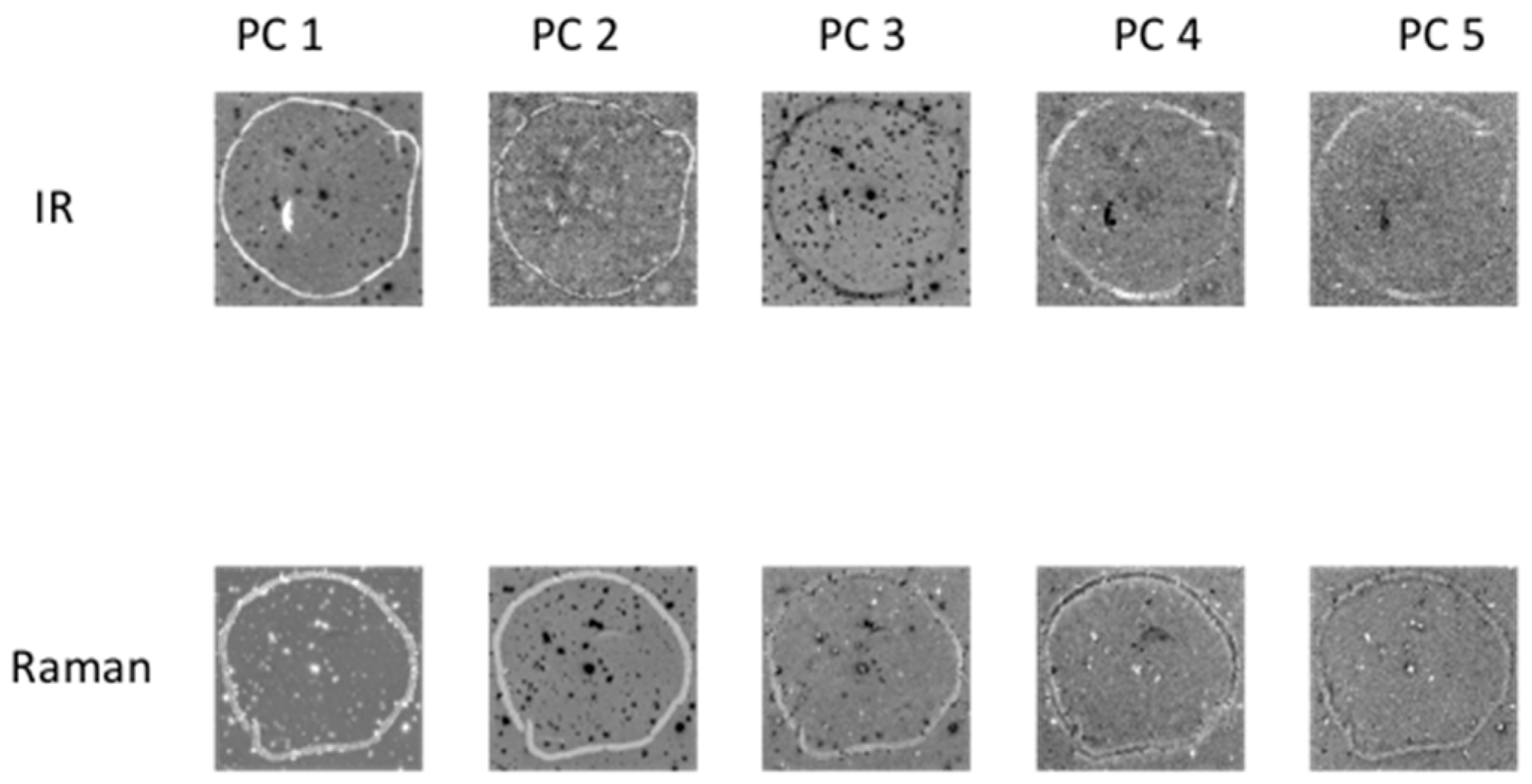


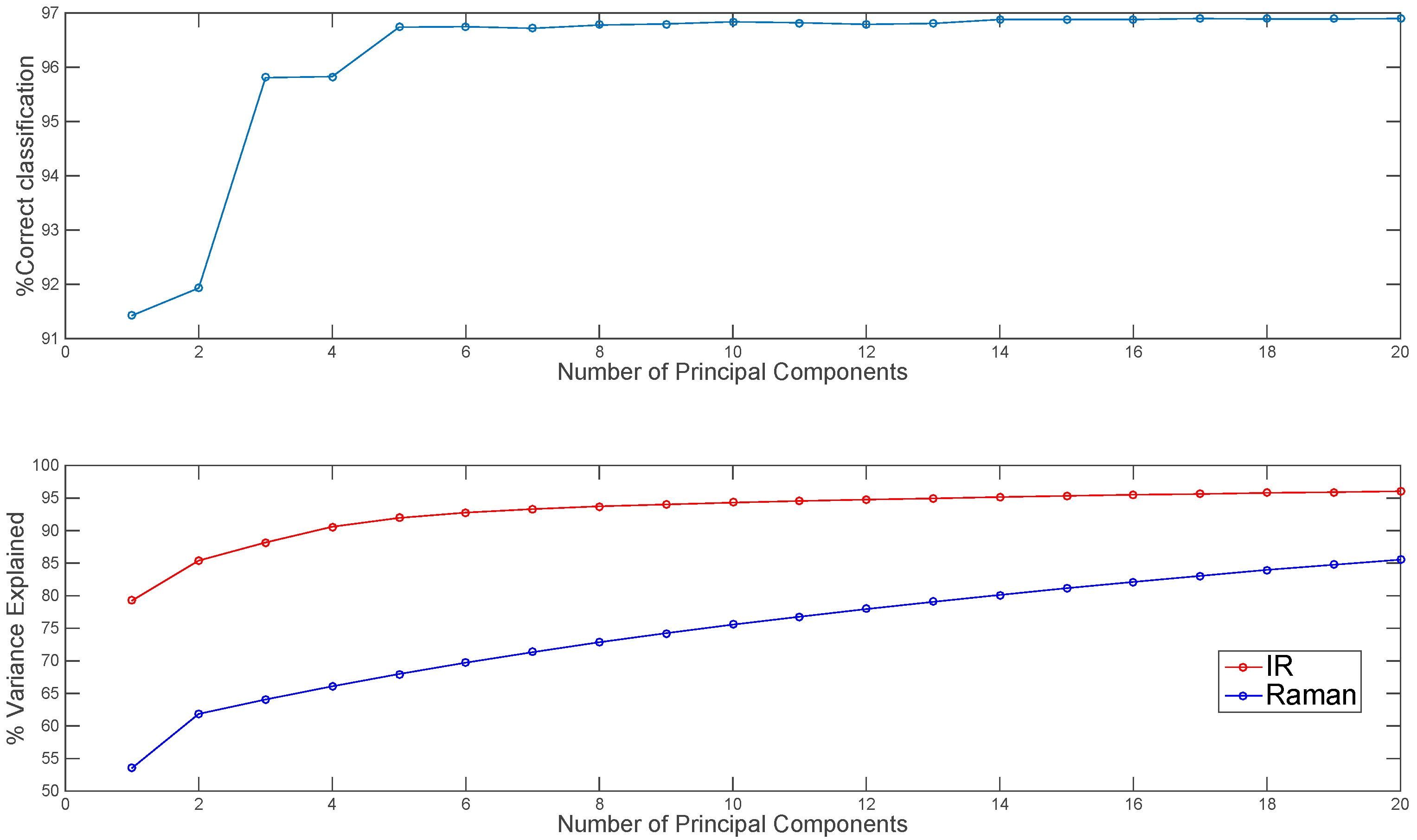
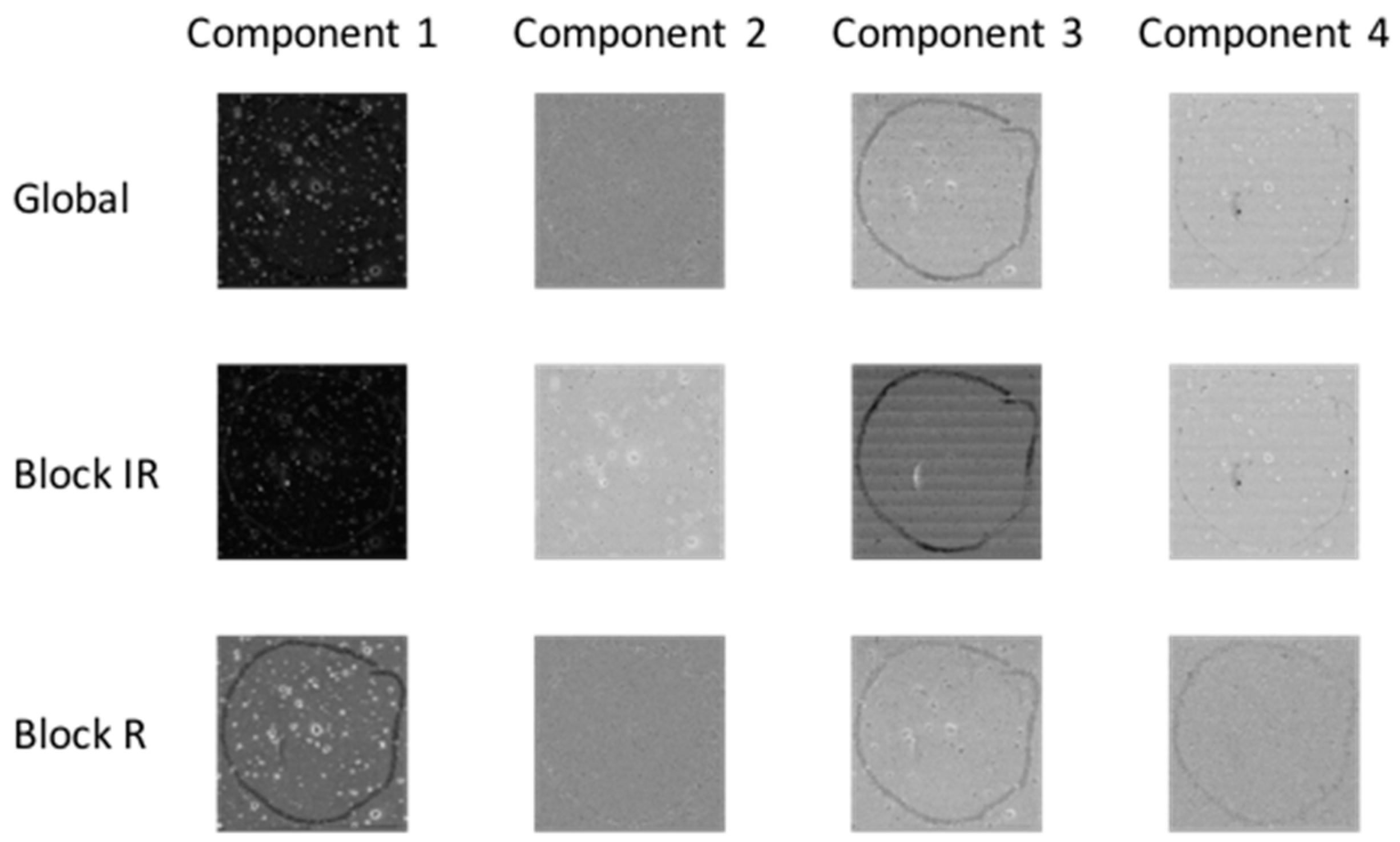
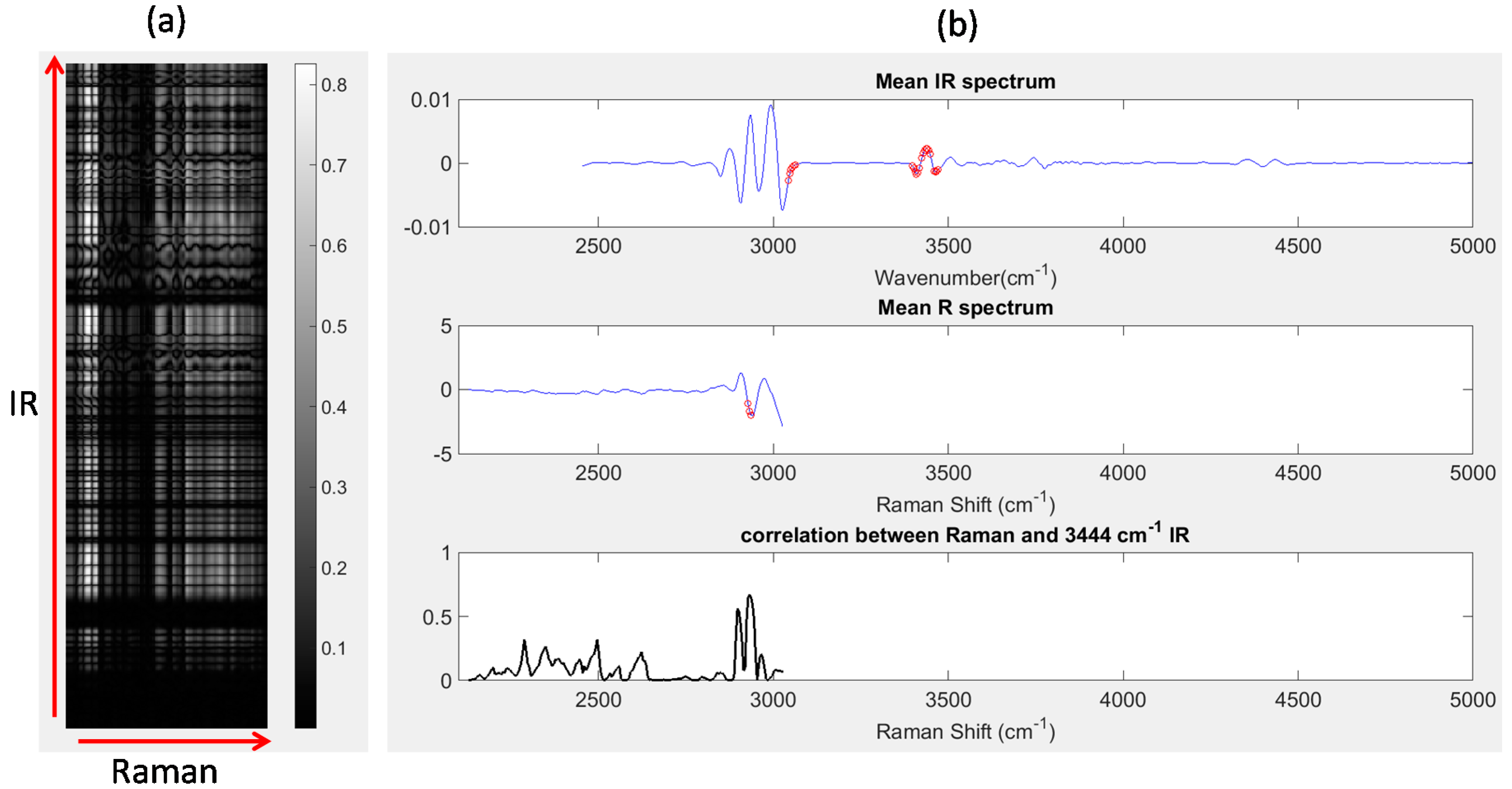
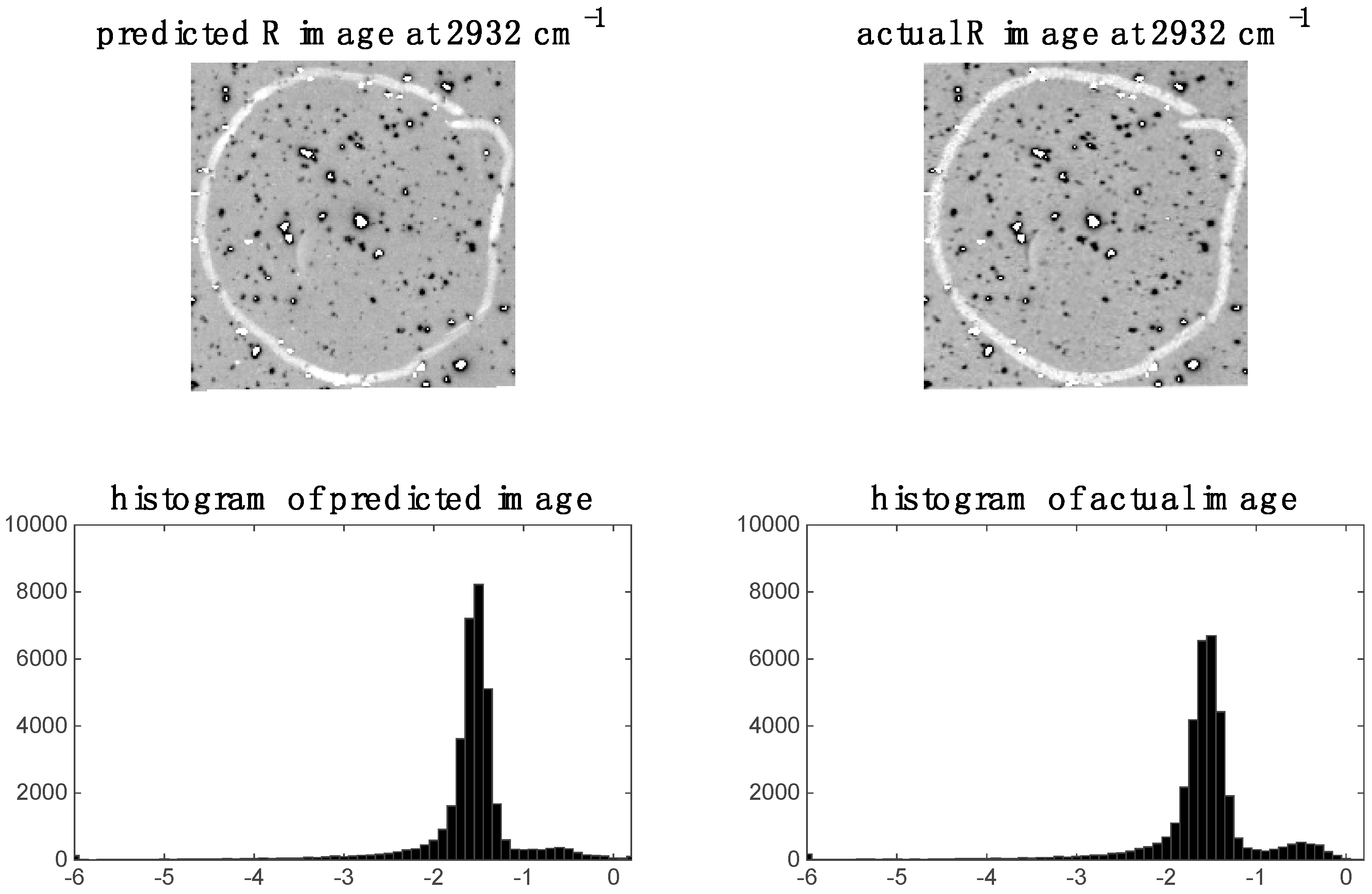
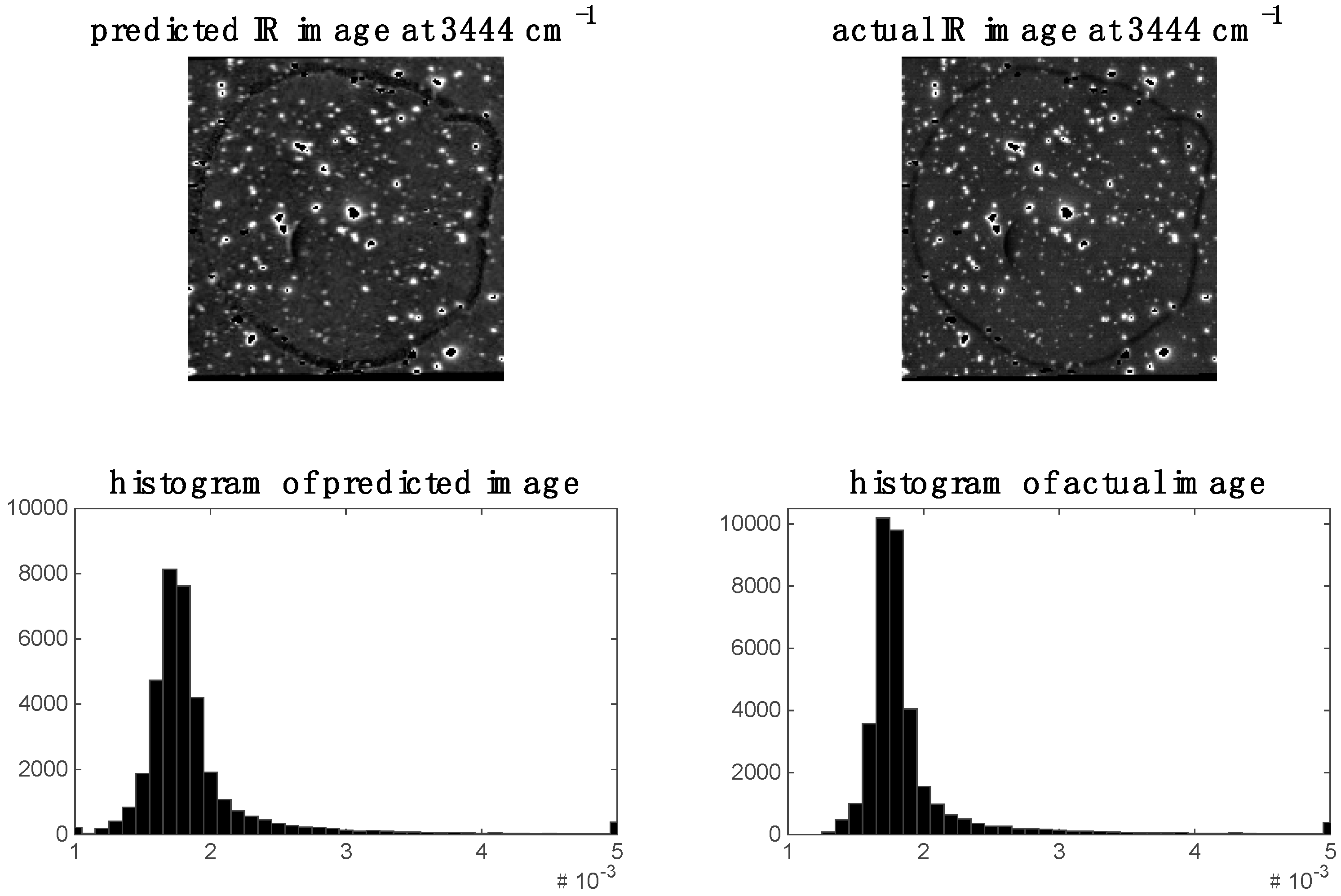
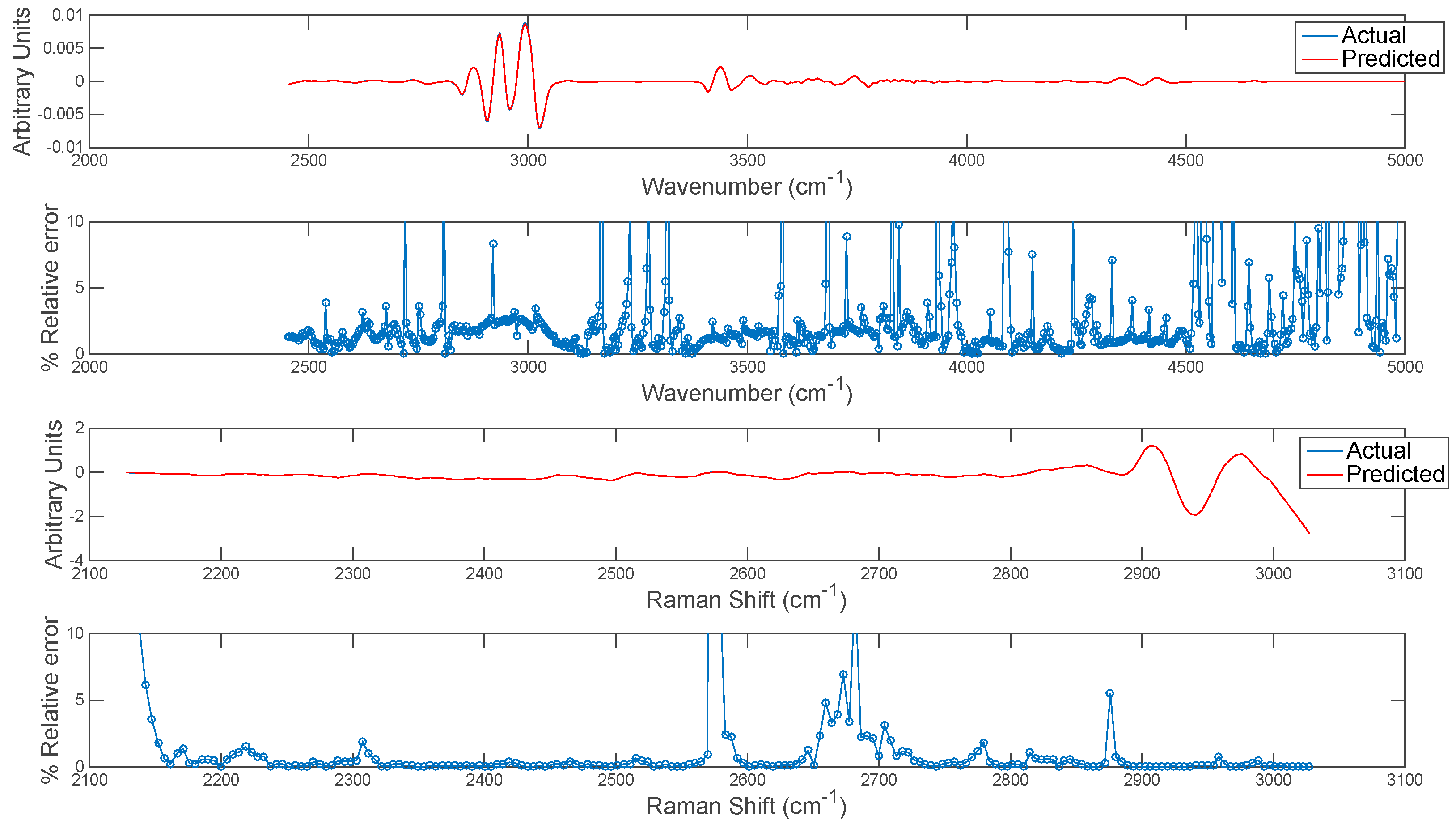
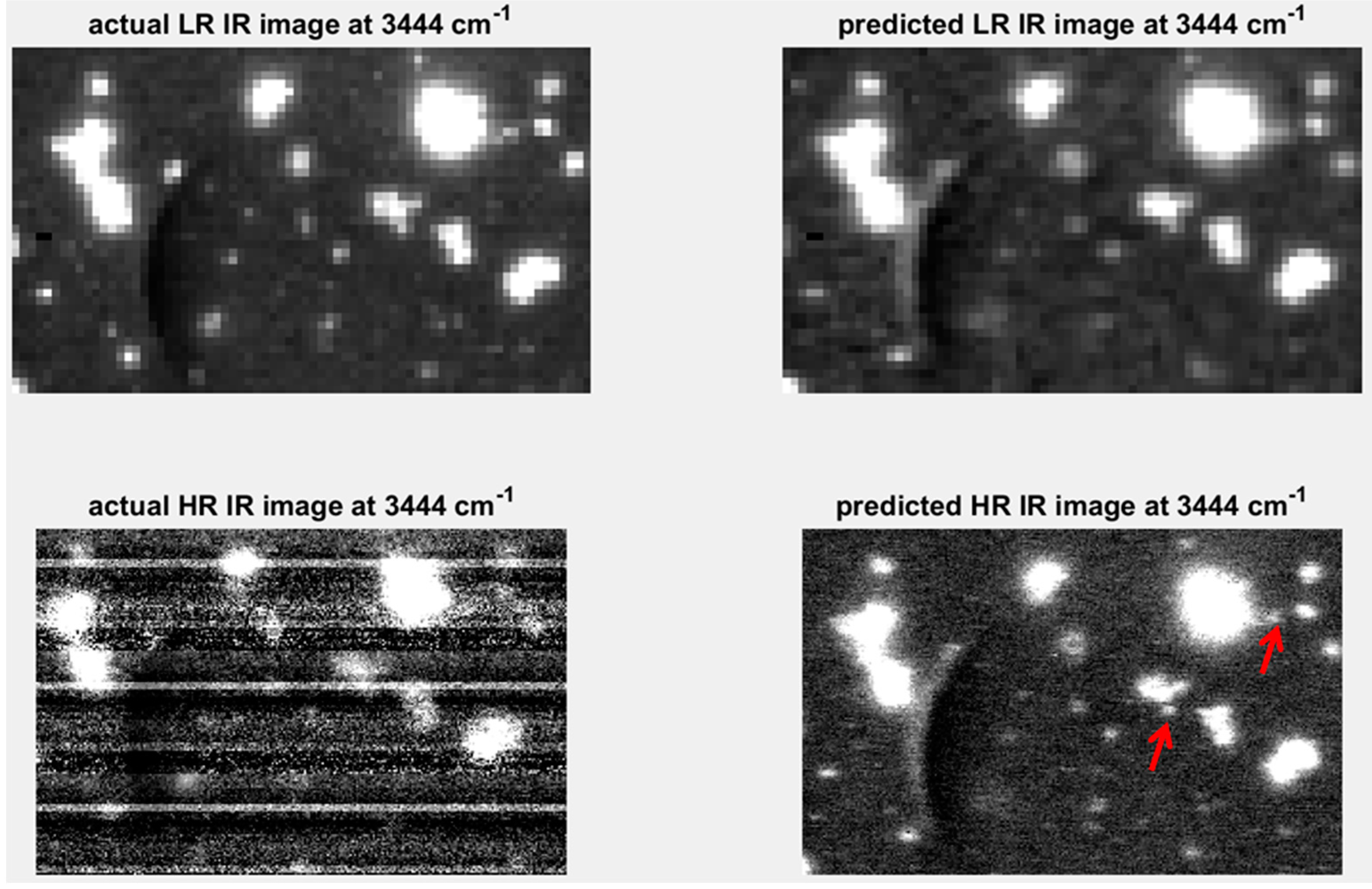
| Dataset | IR only | R only | Low | Mid | High |
|---|---|---|---|---|---|
| % Correct Class | 91.10% | 93.70% | 75.80% | 96.80% | 86.90% |
| #LV in PLS-DA | 3 | 4 | 7 | 6 | 7 |
| Component | 1 | 2 | 3 | 4 | 5 | 6 |
|---|---|---|---|---|---|---|
| Contribution of IR block loadings to global loadings (%) | 58.96 | 25.41 | 46.34 | 79.32 | 76.41 | 3.55 |
| Contribution of R block loadings to global loadings (%) | 41.04 | 74.59 | 53.66 | 20.68 | 23.59 | 96.45 |
| Contribution of IR block components to global components (%) | 31.06 | 1.93 | 12.84 | 34.09 | 30.45 | 0.02 |
| Contribution of R block components to global components (%) | 22.28 | 40.1 | 39.14 | 3.79 | 2.01 | 60.67 |
| Correlation between IR block scores and global scores | 0.889 | 0.286 | 0.677 | 0.967 | 0.976 | 0.03 |
| Correlation between R block scores and global scores | 0.813 | 0.987 | 0.942 | 0.389 | 0.283 | 1 |
| Contribution of block loadings to global loadings (%) | |
| Contribution of block components to global components | |
| Correlation between IR block scores and global scores | Pearson linear correlation coefficient between block and global scores |
© 2016 by the authors. Licensee MDPI, Basel, Switzerland. This article is an open access article distributed under the terms and conditions of the Creative Commons Attribution (CC-BY) license ( http://creativecommons.org/licenses/by/4.0/).
Share and Cite
Gowen, A.A.; Dorrepaal, R.M. Multivariate Chemical Image Fusion of Vibrational Spectroscopic Imaging Modalities. Molecules 2016, 21, 870. https://doi.org/10.3390/molecules21070870
Gowen AA, Dorrepaal RM. Multivariate Chemical Image Fusion of Vibrational Spectroscopic Imaging Modalities. Molecules. 2016; 21(7):870. https://doi.org/10.3390/molecules21070870
Chicago/Turabian StyleGowen, Aoife A., and Ronan M. Dorrepaal. 2016. "Multivariate Chemical Image Fusion of Vibrational Spectroscopic Imaging Modalities" Molecules 21, no. 7: 870. https://doi.org/10.3390/molecules21070870
APA StyleGowen, A. A., & Dorrepaal, R. M. (2016). Multivariate Chemical Image Fusion of Vibrational Spectroscopic Imaging Modalities. Molecules, 21(7), 870. https://doi.org/10.3390/molecules21070870





